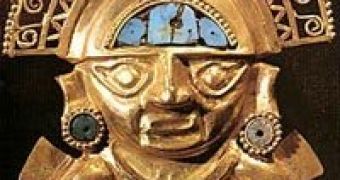When Columbus made his first steps on the American ground (or better said, Caribbean), his mind was set on an El Dorado, a realm of gold and silver riches.
And indeed, they soon discovered two El Dorados: the Inca and the Aztec Empires.
In 1532, Incas paid to Pizzaro, the conquistador of their empire, a ransom consisting in one chamber (of 22x17 ft (7.3x5.7m)) filled with gold and two with silver for their emperor, Atahualpa.
But even if the Incas fashioned magnificent gold, silver, and copper statuettes and jewelry, a new research points that, with all their sophisticated civilization, Incas shouldn't be credited for introducing "industrial scale" metallurgy in South America.
New proofs from Peruvian ancient lake sediments revealed extensive copper and silver metallurgy started around 1000 C.E., five centuries before the rise of the Inca civilization.
It seems that the Inca, like the Spanish conquistadors, looted the artifacts; that's why they left little evidence of previous craftsmanship.
Alexander Wolfe, a paleolimnologist at the University of Alberta in Canada, and his team, were analyzing Bolivian lake sediments for several years to make a model of the ancient climate when they detected a detailed well-preserved timeline of local metal smelting.
Metal particles in the smoke from a smelter get captured in the lake sediment layers due to the rainfall.
In 2003, the team showed proofs of an extensive silver metallurgy in a pre-Incan culture in Bolivia at around 1000 C.E. This matches the fall of the Tiwanaku empire that dominated the region at the time.
Then the team expanded its analyses to lake sediments from Laguna Pirhuacocha, a small lake in the Peruvian Morococha region, the realm of the Wari empire, the largest Andean empire before the Inca.
The investigators detected in sediment signs of lead, titanium, zinc, bismuth, antimony, copper, and silver, associated with copper metallurgy, at around 1000 C.E., roughly the fall of the Wari.
"The timing of the spike is consistent with previous suggestions that Wari and Tiwanaku empires fell because of a drought or some other environmental collapse." said Wolfe.
When the Inca started to rise, the researchers revealed that the metal smiths turned from copper to silver metallurgy, as the Inca rulers preferred this metal for the payment of the heavy tax they imposed.
"I think it's pretty exciting stuff," said Mark Brenner, a paleolimnologist at the University of Florida, Gainesville.
"The levels of lead and other potentially dangerous metals appear to be high enough that they may have caused widespread health effects, such as muscle and joint pain and memory troubles, among the locals. Next up, it may be worth examining the bones of skeletons from the time to see whether they show effects from the rise of the Andes' original large scale metalworks." added Brenner.

 14 DAY TRIAL //
14 DAY TRIAL //